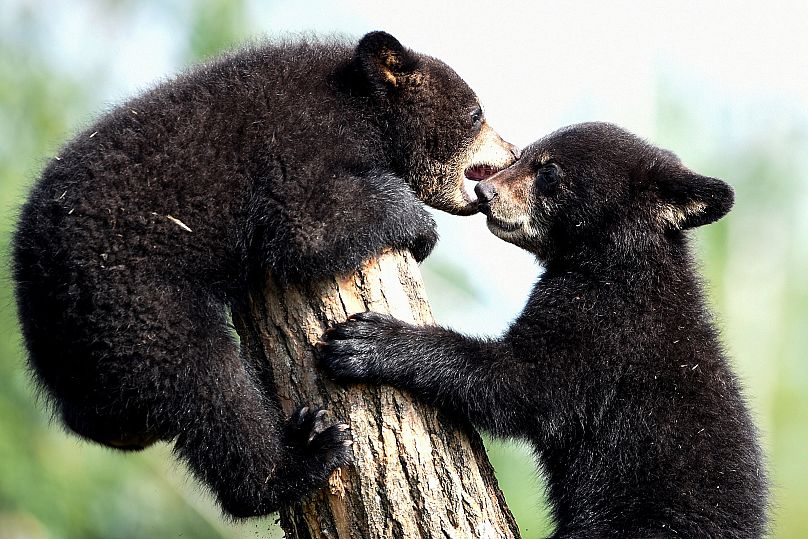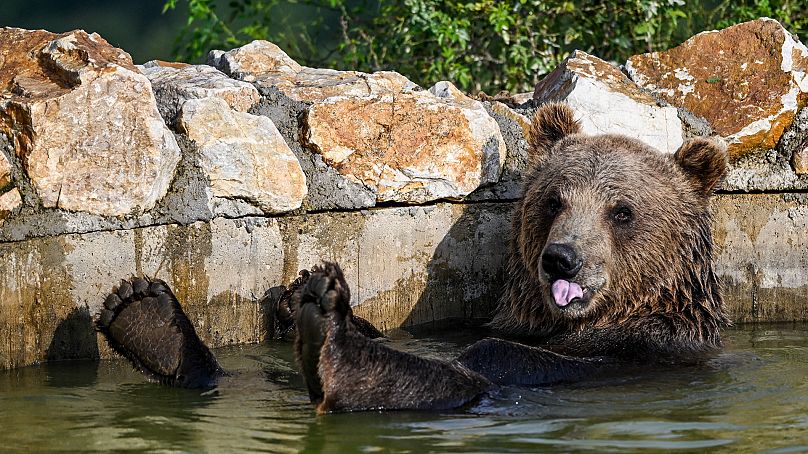The bear had been brought back to the region through a rewilding programme.
The fate of a 17-year-old bear in the Italian Alps is still undecided after it killed a 26-year-old jogger earlier this month.
"The risk [of a bear attack] is not zero, but perhaps this tragedy could have been prevented," WWF naturalist Marco Antonelli said after Andrea Papi's funeral. The 26-year-old was killed by a bear dubbed Jj4 on April 5 in the region of Trentino-South Tyrol in Northern Italy.
Are bear attacks common in the Alps?
This was not the first time Jj4 had attacked people in the Alps. In 2022, it attacked a father and son - sparking a killing order that was eventually overturned by the courts.
A similar thing happened just a few days after Papi's death when an ordinance to cull Jj4 by the president of the autonomous province of Trentino, Maurizio Fugatti, was suspended by the Regional Administrative Tribunal.
The decision came after an appeal to save the bear was filed by a pair of environmentalists named Lav and Lac. They offered to take the bear into their custody to save its life.
The administrative court accepted the appeal as it waits for the case file on the attack and the medical reports to determine the causes of Papi's death and the type of wounds found on his body.
The president responded to the move by reaffirming his position that Jj4 should be culled but he told Lav and Lac: 'If you want bears, we have another 70 specimens to move".
Two mayors from the region have since joined in the calls to save the bear's life.
Bringing bears to the Alps
The controversy around the life of Jj4 stems from a decades-long project to reintroduce bears to Trentino.
In 1999, the Adamello Brenta Park - with the Autonomous Province of Trento, the National Institute of Wild Fauna, and funding from the European Union - launched the Life Ursus project, aimed at re-establishing a colony of bears in the central Alps.
Over a three-year period, 10 bears were transported from Slovenia to Trentino. In around 20 years, those initial 10 bears have become hundreds. And even Jj4 gave birth to cubs in January 2022.
But as the number of bears multiplied so did reports of encounters between them and residents and tourists.
Accidents, however, are rare. Bears are more likely to be afraid of people instead of considering them their prey. In Sweden - where there are between 4,000 and 5,000 bears compared to about 100 in Trentino - there is only around one accident every year, according to Piero Genovesi, the head of Ispra's Wildlife Coordination Service.
He added in a conversation with the daily newspaper La Repubblica that there have only been two bear-related deaths in the past 15 years.
Over that same period, there have only been around 11 fatal attacks in Romania, where the bear population is over 6,000.
Why is the rewilding project important?
According to WFF's Antonelli, the rewilding project is important because bears were once an important part of the region's ecosystem. "There were bears in the Italian Alps in the last century before they were eradicated by human persecution and widespread anthropisation," he said.
"Bringing back a species that was an integral part of the ecosystem was fundamental."
Before the reintroduction of bears to Trentino, researchers spent years determining the socio-economic and ecological feasibility of the project.
In the late 1990s, public opinion was overwhelmingly in favour of bringing the bears back, with more than 70 per cent of the population in favour. "The facts," Antonelli said, "have shown that the studies were right since there are now about a hundred bears [in the area]."
Educating the public
One of the pitfalls of the project, according to Antonelli, is that the public hasn't been educated on how to interact with bears.
"We should have taken a cue from North America," he said, "where there is very specific signage [notifying the public on] the fact that there are bears in the area and how to behave with the bear [...] Perhaps poor Andrea was suddenly confronted with the bear, the bear got scared and reacted the way a bear reacts.
"It is irresponsible to say that bears should be killed, and it is a [knee-jerk reaction]."
In addition to a lack of education, Antonelli added that there has been little work done to facilitate the movement of bears from one territory to another.
In practice, the bears should have repopulated the entirety of the Alps, moving from one area to another through ecological corridors. But they have remained stuck in western Trentino, their path blocked by rivers, roads and villages.
Information campaigns are not enough
Kai Elmauer, a naturalist and expert on human-fauna coexistence, also thought educating the local population was crucial to maintaining their safety. But, he said, humans and bears have to learn to coexist.
"There is a much greater chance that [a bear] will mistake [a human] for prey if they have never met before," Elmauer explained. He added that educating the population is not just showing a video and putting up a sign but explaining what to do in practice.
An injured or frightened bear is even more dangerous. And a person using a stick to defend themselves, for example, "is far more dangerous than a person using pepper spray."
"In the Brenta, Life Ursus has spent a lot of money educating people," he said. "However, it has largely been done in a classical way: presentations, downloading information, with folders and other printed material, videos, etc.
"This educational approach is not effective in guiding or changing behaviour. I see the same approach and its limitations in British Columbia, where the authorities try to educate residents on how to [dispose of their rubbish properly] because it is a strong attraction for bears. But if we went to check how many people have bear spray, we would probably find that it is less than 50 percent."
Why kill bears?
In Slovenia, the Minister of Natural Resources and Territorial Affairs, Uroš Brežan, has called for the culling of 230 brown bears.
He argued that 800 bears are the ideal number for the safety and health of the population. There are currently 1,100 bears in the country.
And while activists have decried the decision, others have argued that mass culling can be done ethically.
"My steadfast advice is to make sure you quickly increase the bear population to a level that would allow hunting," Elmauer said.
"This is not to create hunting opportunities, but to allow managers to destroy bears that have a tendency to create risky situations such as hanging out in neighbourhoods, or routinely getting close to people."
Watch the video above for more on the story of Jj4.














